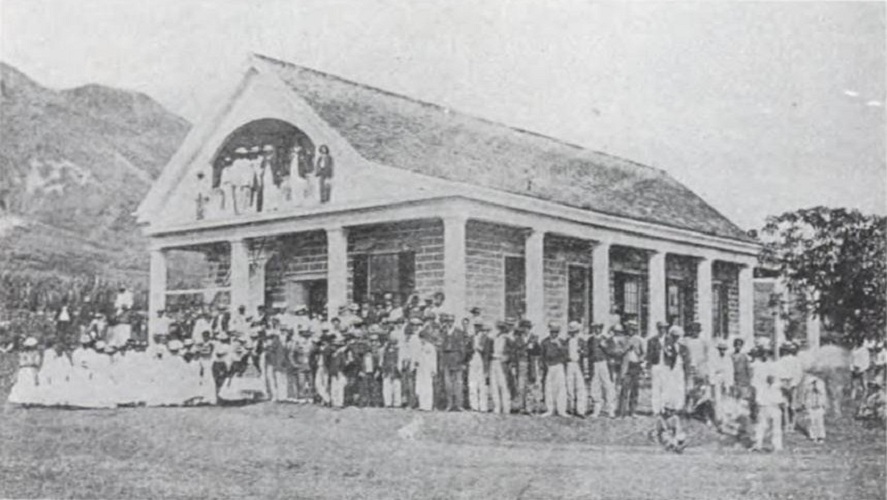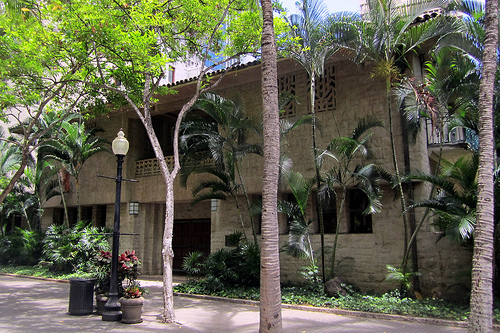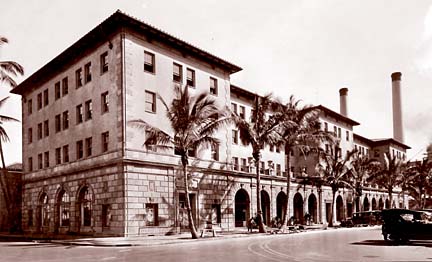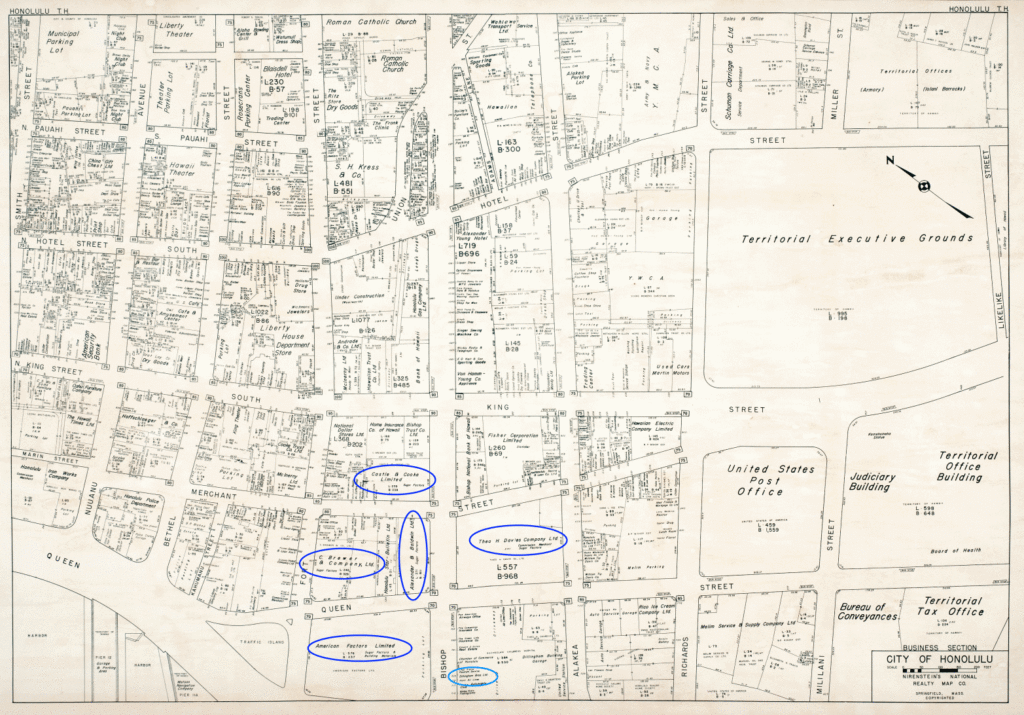“Very near to (the site of Queen’s Hospital,) on Sept. 2, 1838, I was born. My father’s name was Kapaʻakea, and my mother was Keohokālole; the latter was one of the fifteen counsellors of the king, Kamehameha III., who in 1840 gave the first written constitution to the Hawaiian people.”
“My great-grandfather, Keawe-a-Heulu, the founder of the dynasty of the Kamehamehas, and Keōua, father of Kamehameha I., were own cousins, and my great-grandaunt was the celebrated Queen Kapiʻolani, one of the first converts to Christianity. “
“She plucked the sacred berries from the borders of the volcano, descended to the boiling lava, and there, while singing Christian hymns, threw them into the lake of fire.”
“This was the act which broke forever the power of Pele, the fire-goddess, over the hearts of her people. Those interested in genealogies are referred to the tables at the close of this volume, which show the descent of our family from the highest chiefs of ancient days.”
“Naihe, the husband of Kapiʻolani, was the great orator of the king’s reign; his father, Keawe-a-Heulu, was chief counsellor to Kamehameha I; while had it not been for the aid of the two chiefs, Keʻeaumoku and Kameʻeiamoku, cousins of the chief counsellor, the Hawaiian Islands must have remained for a long time”.
My grandfather, ʻAikanaka, had charge of the guns of the fort on Punch-Bowl Hill, which had been brought from the larger island of Hawaii; as the chiefs, their families, and followers had settled here from the time of the final battle, when all the forces contending against Kamehameha I were driven over the Pali.”
“But I was destined to grow up away from the house of my parents.”
“Immediately after my birth I was wrapped in the finest soft tapa cloth, and taken to the house of another chief, by whom I was adopted. Konia, my foster-mother, was a granddaughter of Kamehameha I, and was married to Paki, also a high chief; their only daughter, Bernice Pauahi, afterwards Mrs. Charles R. Bishop, was therefore my foster-sister.”
“In speaking of our relationship, I have adopted the term customarily used in the English language, but there was no such modification recognized in my native land.”
“When I was taken from my own parents and adopted by Paki and Konia, or about two months thereafter, a child was born to Kīna‘u. That little babe was the Princess Victoria, two of whose brothers became sovereigns of the Hawaiian people.”
“While the infant was at its mother’s breast, Kīna‘u always preferred to take me into her arms to nurse, and would hand her own child to the woman attendant who was there for that purpose.”
“So she frequently declared in the presence of my adopted mother, Konia, that a bond of the closest friendship must always exist between her own baby girl and myself as aikane or foster-children of the same mother …”
“… and that all she had would also appertain to me just as if I had been her own child; and that although in the future I might be her child’s rival, yet whatever would belong to Victoria should be mine.”
“This insistence on the part of the mother was never forgotten; it remained in the history of Victoria’s girlhood and mine until her death, although Kīna‘u herself never lived to see her prophetic predictions fulfilled. Kīna‘u died on the 4th of April, 1839, not long after the birth of her youngest child, Victoria.”
“I knew no other father or mother than my foster-parents, no other sister than Bernice. I used to climb up on the knees of Paki, put my arms around his neck, kiss him, and he caressed me as a father would his child …”
“… while on the contrary, when I met my own parents, it was with perhaps more of interest, yet always with the demeanor I would have shown to any strangers who noticed me.”
“My own father and mother had other children, ten in all, the most of them being adopted into other chiefs’ families; and although I knew that these were my own brothers and sisters, yet we met throughout my younger life as though we had not known our common parentage.”
“This was, and indeed is, in accordance with Hawaiian customs. It is not easy to explain its origin to those alien to our national life, but it seems perfectly natural to us.”
“As intelligible a reason as can be given is that this alliance by adoption cemented the ties of friendship between the chiefs. It spread to the common people, and it has doubtless fostered a community of interest and harmony.”
“At the age of four years I was sent to what was then known as the Royal School, because its pupils were exclusively persons whose claims to the throne were acknowledged. It was founded and conducted by Mr Amos S Cooke, who was assisted by his wife.”
“It was a boarding-school, the pupils being allowed to return to their homes during vacation time, as well as for an occasional Sunday during the term.”
“The family life was made agreeable to us, and our instructors were especially particular to teach us the proper use of the English language; but when I recall the instances in which we were sent hungry to bed, it seems to me that they failed to remember that we were growing children.”
“A thick slice of bread covered with molasses was usually the sole article of our supper, and we were sometimes ingenious, if not over honest, in our search for food …”
“… if we could beg something of the cook it was the easier way; but if not, anything eatable left within our reach was surely confiscated.”
“As a last resort, we were not above searching the gardens for any esculent root or leaf, which (having inherited the art of igniting a fire from the friction of sticks), we could cook and consume without the knowledge of our preceptors.”
“I can remember now my emotions on entering this the first school I ever attended. I can recall that I was carried there on the shoulders of a tall, stout, very large woman, whose name was Kaikai (she was the sister of Governor Kanoa, and they were of a family of chiefs of inferior rank, living under the control and direction of the higher chiefs).”
“As she put me down at the entrance to the schoolhouse, I shrank from its doors, with that immediate and strange dread of the unknown so common to childhood.”
“Crying bitterly, I turned to my faithful attendant, clasping her with my arms and clinging closely to her neck. She tenderly expostulated with me …”
“… and as the children, moved by curiosity to meet the new-comer, crowded about me, I was soon attracted by their friendly faces, and was induced to go into the old courtyard with them. Then my fears began to vanish, and comforted and consoled, I soon found myself at home amongst my playmates.”
“We never failed to go to church in a procession every Sunday in charge of our teachers, Mr. and Mrs. Cooke, and occupied seats in the immediate vicinity of the pew where the king was seated.”
“The custom was for a boy and girl to march side by side, the lead being taken by the eldest scholars. Moses and Jane had this distinction, next Lot and Bernice, then Liholiho with Abigail, followed by Lunalilo and Emma (after the latter had joined the school), James and Elizabeth, David and Victoria, and so on, John Kīna’u and I being the last.”
“From the school of Mr. and Mrs. Cooke I was sent to that of Rev. Mr. Beckwith, also one of the American missionaries. This was a day-school, and with it I was better satisfied than with a boarding-school.” (Lili‘uokalani)















































